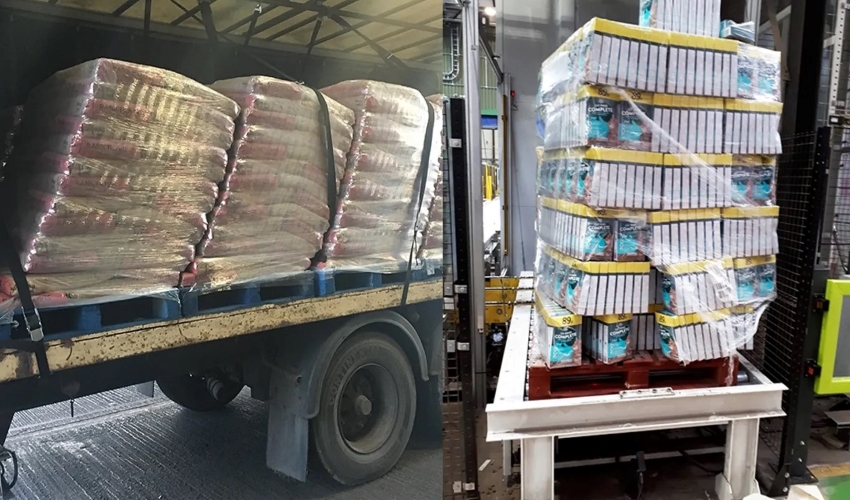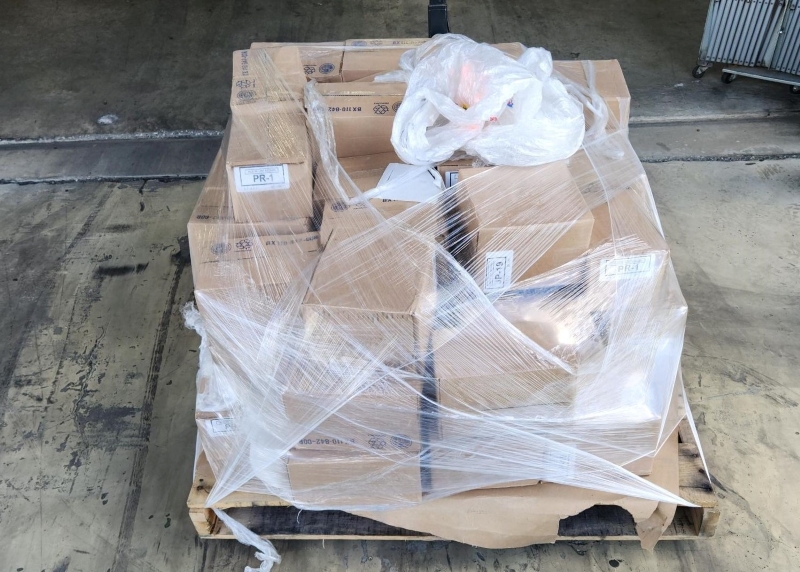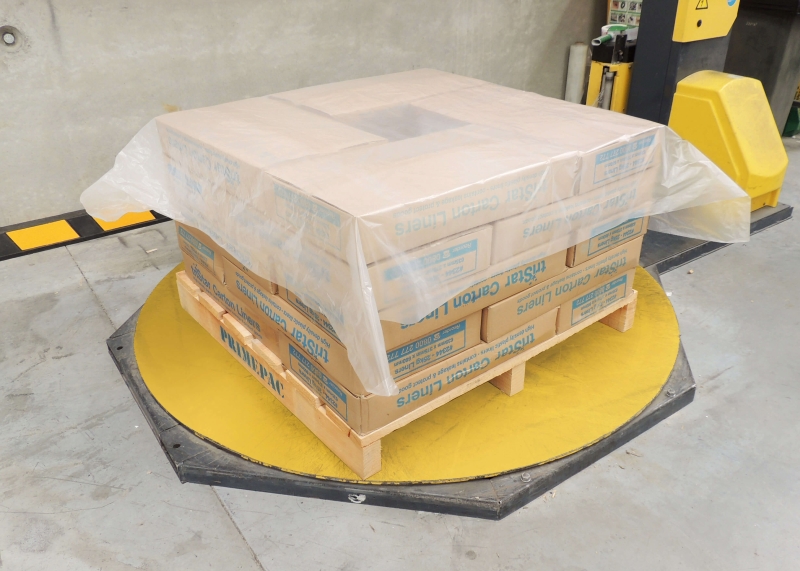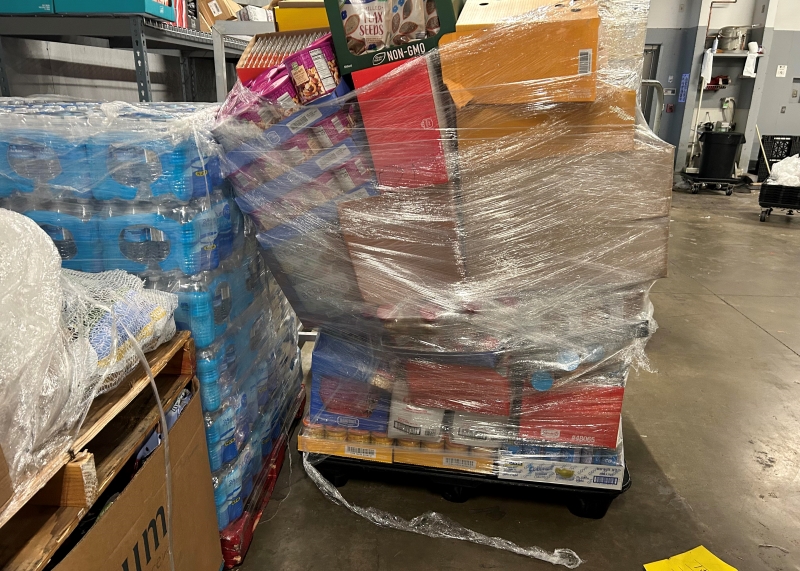
Poor pallet wrap refers to the inadequate application or choice of wrapping materials that fail to securely hold loads on pallets during transport and storage. This problem, often resulting from low-quality film, improper wrapping techniques, or insufficient wrap tension, can lead to unstable loads that shift, lean, or even collapse. Poor pallet wrap is a significant issue in logistics, as it increases the risk of product damage, delays, and costly returns. Using proper techniques and suitable materials like PWP Stretch Film can prevent these risks, ensuring that pallets remain stable throughout their journey and reducing the likelihood of accidents or loss in storage and transit. Poor pallet wrap occurs when packaging materials fail, causing stretch wrap tearing, inconsistent restraints, or poor load adhesion during transport.
Poor pallet wrap occurs when pallets are wrapped with inadequate materials or improper techniques, compromising the stability of goods during transport and storage. This section explores the primary factors contributing to poor pallet wrap, emphasizing common challenges that can be prevented with the right knowledge and practices.

Here are the main causes of bad wrapped pallets:
Proper technique is essential for ensuring that pallets are securely wrapped, yet many workers lack adequate training in this area. Poor pallet wrap often results from rushed or inconsistent wrapping methods, which can leave the pallet insufficiently secured. Here’s how inadequate training impacts wrap quality:
How to Avoid:
The quality of the stretch film itself significantly impacts the effectiveness of pallet wrapping. Poor pallet wrap frequently arises when low-quality films are used, as these films are more likely to tear or stretch unevenly, leading to inadequate load stability. High-quality films, such as those offered by PWP Stretch Film, are designed to handle the rigors of transportation. Common issues with low-quality films include:
How to Avoid:
Proper tension is critical to effective pallet wrapping. When the tension applied to the film is too loose, it fails to exert enough containment force to keep the pallet stable. On the other hand, excessive tension can cause the film to tear. Achieving the correct balance requires specific knowledge and technique. Common issues related to insufficient tension include:
How to Avoid:
Using the wrong type or size of stretch wrap can result in wasted materials and improper load control, potentially leading to product damage. To avoid this mistake, ensure you understand the different types of stretch films (e.g., cast vs. blown film) and their proper applications. Additionally, make sure the film you select is the correct size for your pallets. Avoid excessive waste and under-wrapping by choosing a stretch wrap that suits the load’s weight and shape.
How to Avoid:
One of the most common mistakes in pallet wrapping is not using enough stretch film, leading to inadequate security and potential product shifting. Whether wrapping manually or with a machine, always ensure the wrap extends far enough around the entire pallet for optimal security.
How to Avoid:
Choosing the wrong size or damaged pallet can result in unstable packaging, leading to product movement, damage, and even injury. Make sure the pallet is the right size to hold your products securely, without overhanging or causing compression damage. Reusing old or broken pallets can be dangerous.
How to Avoid:
Incorrect stacking of boxes can significantly increase the risk of damage. Common mistakes include stacking boxes in a way that does not distribute weight properly or using a pallet that is too small, causing overhang and increasing the risk of breakage.
How to Avoid:
Simply wrapping the top of the pallet without securing the base is inadequate for ensuring stability. The base of the pallet bears the most stress, and leaving it unsecured can cause the entire load to shift during transport.
How to Avoid:
The amount of overlap in the stretch film can significantly affect the stability of the pallet. Too little overlap can result in weak spots, while too much overlap leads to unnecessary material waste.
How to Avoid:
Damage to the wrap, such as tears, holes, or weak spots, can compromise the security of the pallet. Always inspect the wrapped pallet before shipping to ensure that the packaging is intact and secure.
How to Avoid:
Environmental conditions like temperature and humidity can affect the performance of stretch film. For example, cold temperatures may cause the film to become brittle, while high humidity can reduce its adhesive properties. Ignoring these factors can result in poor performance during transit.
How to Avoid:
The causes of poorly wrapped pallets is crucial for improving load stability. By focusing on effective training, investing in high-quality materials like PWP Stretch Film, and ensuring proper tension, companies can significantly enhance the safety and security of their wrapped loads during transport.
Poor pallet wrap has significant implications for the safety and stability of goods during transit and storage. Inadequate pallet wrapping techniques or materials compromise the integrity of pallets, putting shipments at risk of damage, delays, and costly losses. Understanding the consequences of poorly wrapped pallet allows businesses to appreciate the importance of effective pallet wrapping practices. Below, we explore the negative impacts on load stability and product safety, along with examples of potential damage and financial repercussions.
Poor pallet wrap directly affects the ability of pallets to maintain stability during movement. When pallets are improperly wrapped, they become vulnerable to shifting, tipping, and collapsing. These outcomes not only endanger the products but also pose risks to workers handling or transporting the goods. The negative impacts include:
The financial implications of poor pallet wrap are extensive, as companies often face direct costs from damaged goods and indirect costs from returns, customer dissatisfaction, and re-wrapping. Examples of potential damage and financial losses include:
To avoid these costly consequences, it’s vital to invest in high-quality materials, such as PWP Stretch Film, and train staff on effective pallet wrapping techniques. Recognizing the risks associated with poor pallet wrap can guide companies in improving their processes, protecting product integrity, and ensuring smoother, safer logistics.
Recognizing signs of poor pallet wrap is essential to maintain the stability and safety of goods during storage and transportation. Identifying these indicators early can help prevent potential damage and reduce costs associated with product returns or rewrapping. Here are the main signs that suggest poor pallet wrap is being used.

Poor pallet wrap practices can often be identified by visual and structural indicators that compromise the load’s security. Here are some common signs that poor pallet wrap may be affecting your shipments:
One of the primary indicators of poor pallet wrap is loose wrap that fails to hold the load securely. When the stretch film lacks proper tension or overlap, it results in shifting loads, making the entire pallet unstable. This movement within the load increases the likelihood of product damage and accidents during transport. Indicators of loose wrap include:
Tears and punctures are physical signs of poor-quality wrapping or improper application. Tears typically occur when the film lacks durability or is overstretched, while punctures may result from sharp edges or poor-quality film that can’t withstand the load’s weight. When using high-quality wrap film like PWP Stretch Film, such issues are minimized, as these films are designed to handle high tension and protect against punctures. Common causes of tears and punctures include:
Poor pallet wrap practices often fail to provide adequate containment for the products on the pallet. Effective containment means that the film holds all items firmly in place without movement. Ineffective containment is evident when:
While the above signs are common indicators of poor pallet wrap, other visual cues also reveal inadequate wrapping practices. Noticing these subtle signs can help prevent load instability:
Identifying poor pallet wrap practices helps to take corrective action quickly. Observing these signs and choosing materials like PWP Stretch Film designed for load containment will ensure better protection, less damage, and safer handling of goods. By maintaining awareness of these indicators, companies can improve their pallet wrapping processes and reduce the risks associated with poor pallet wrap practices.
Identifying the signs of poor pallet wrap early on is essential to prevent load instability, product damage, and potential safety hazards during transport and storage. Recognizing these indicators allows businesses to address wrapping issues before they lead to costly consequences. Here, we delve into what constitutes a poorly wrapped pallet sign, the visual cues to look for, and the importance of detecting these signs.
A poorly wrapped pallet sign refers to visible indications that a pallet has been inadequately wrapped, resulting in compromised load stability and containment. These signs often stem from improper wrap application, low-quality materials, or insufficient containment techniques. At PWP Stretch Film, we prioritize high-quality wrapping materials that resist common issues, helping clients avoid these red flags in their wrapping practices. Typical poorly wrapped pallet signs include misalignment, loose wrapping, and uneven containment force across the load.
Recognizing the physical indicators of poor pallet wrap helps prevent further issues during transport and storage. These visual cues serve as early warnings, allowing handlers to identify poorly wrapped pallets and make necessary adjustments. Key indicators of poorly wrapped pallets include:
Recognizing the signs of poor pallet wrap is crucial for maintaining safe, efficient transport and storage operations. Addressing these signs helps reduce the risks associated with load instability and ensures that pallets are properly secured. The key benefits of identifying poor pallet wrap signs include:
Understanding the poorly wrapped pallet sign helps companies maintain high standards for load stability and safety, particularly in high-demand storage and transportation environments. With quality materials like those offered by PWP Stretch Film, businesses can avoid common pitfalls in pallet wrapping, ensuring their loads remain secure and protected from departure to destination.
Improving pallet wrap quality is essential for avoiding the risks associated with poor pallet wrap, which can lead to product damage, safety hazards, and costly returns. Effective solutions involve selecting appropriate materials, applying correct wrapping techniques, and ensuring that all staff are well-trained in pallet wrapping methods. Here, we provide key tips to enhance pallet wrap quality and secure loads more effectively.

Selecting high-quality materials and using effective techniques are crucial for enhancing pallet wrap quality. A durable, well-suited stretch film provides the foundation for stable and secure wrapping. When combined with proper application methods, it minimizes the risks associated with shifting loads and wrap failures. Here are some important factors to consider:
High-quality stretch film, like PWP Stretch Film, plays a vital role in preventing poor pallet wrap outcomes. Inferior films are more likely to tear, stretch unevenly, or lose tension over time. A premium stretch film offers the following advantages:
Properly configured machine settings and careful manual wrapping techniques can significantly improve wrap quality. Each pallet requires a specific approach based on its load characteristics and the type of film used. Consider these best practices:
Quality pallet wrap material and optimized techniques alone won’t prevent poor pallet wrap if staff are unfamiliar with correct wrapping practices. Comprehensive training equips employees with the skills to wrap pallets effectively, reducing the need for re-wrapping and preventing load instability. Key areas to cover in training include:
By focusing on high-quality materials, precise techniques, and thorough employee training, companies can avoid the pitfalls of poor pallet wrap. This proactive approach not only enhances load stability and product safety but also contributes to overall operational efficiency. Working with trusted film brands like PWP Stretch Film further ensures reliable containment that keeps goods protected from departure to destination.
Several eco-friendly and reusable alternatives to traditional pallet wrapping offer effective load stabilization without relying on single-use plastic films. Some popular alternatives include:
Strapping: Typically made of plastic or metal, strapping secures loads tightly around the pallet and is especially effective for stable, uniform items. While cost-effective, strapping is best suited for loads that don’t shift easily, as it may not provide complete containment for irregularly shaped goods.
Reusable Pallet Wraps: Made from durable, reusable materials, these wraps are designed to replace single-use plastic wraps while still keeping loads stable. Reusable wraps often have buckles or Velcro closures for easy application and removal. Although they require cleaning for hygiene, they provide a sustainable option for companies focused on reducing waste.
Pallet Bands: Elastic pallet bands can stabilize products on a pallet without covering them entirely. They’re simple to apply and work well for various load sizes. However, due to recycling limitations, pallet bands may not be ideal for all businesses.
Shipping Containers or Crates: For high-value or fragile items, crates and containers offer maximum protection during transit. Although more expensive than other methods, they provide security and environmental benefits, as they are often reused many times.
Each alternative has its benefits and is suitable for different types of loads, making it essential to choose the option that aligns with your specific logistics needs and sustainability goals.
Proper pallet wrapping is essential for load stability, product safety, and efficient transportation. Here’s a step-by-step guide on how to correctly wrap a pallet:
Start by Positioning the Pallet: Place the pallet on a flat, stable surface. Ensure that it’s fully loaded with items positioned evenly and without overhanging to create a compact, stable structure.
Secure the Base Layer: Begin wrapping at the base of the pallet, tucking the initial stretch film between the pallet and bottom layer to secure it. This step ensures that the wrap is anchored and won’t unravel during the process.
Apply Spiral Wrapping Technique: Wrap the pallet in a spiral motion, gradually moving upward. Overlap each layer by about 50% to create a uniform, secure layer. Each rotation should add to the containment force, ensuring that the load is stable.
Secure the Top Layer: When you reach the top of the pallet, stretch the wrap over the top edges to lock down items and prevent shifting. For added stability, consider using additional horizontal wraps.
Return to the Base: After securing the top, spiral back down to the base of the pallet, ensuring the wrap is tightly applied. End by tucking or securing the wrap to prevent it from coming loose.
Following these steps ensures that your pallet is correctly wrapped, keeping loads stable and minimizing the risk of damage during transit. Proper wrapping techniques also save material, which can reduce waste and lower costs over time.
The thickness of pallet wrap plays a significant role in its effectiveness and durability. A typical poor pallet wrap may be too thin, leading to insufficient load security and a higher risk of damage during transport. Generally, pallet wraps range from 8 to 20 microns in thickness, with thicker films offering better strength and durability. For light loads, a thinner wrap (8-12 microns) might suffice, but for heavier, bulkier loads or those exposed to rough conditions, thicker wraps (15-20 microns) are recommended. A poor pallet wrap that is too thin may tear easily, fail to provide adequate tension, or not offer the necessary protection from environmental factors like moisture or UV light. Proper wrap thickness ensures a secure load, reduces waste, and minimizes costs by reducing the need for multiple layers.
The cost of a pallet wrap can vary significantly depending on several factors such as the quality of the film, thickness, and type (stretch, cast, or blown film). A poor pallet wrap, often made of lower-quality materials or thinner films, might be priced lower, typically ranging from $20 to $40 per roll for basic stretch films. However, the lower upfront cost often comes with compromises in durability and effectiveness, potentially leading to higher long-term costs due to increased usage or product damage. On the other hand, high-quality, durable pallet wraps with better performance features (such as greater stretchability or puncture resistance) may cost $50 to $100 or more per roll. When purchasing pallet wrap, it’s important to balance cost with quality to ensure the film provides adequate protection and cost-efficiency in the long run.
Blown pallet wrap is a type of stretch film produced using a specific extrusion process known as the blown film extrusion process. This process involves melting plastic resin and forcing it through a circular die, creating a tube of film that is inflated into a bubble, which is then flattened to produce the wrap. Poor pallet wrap may be made using this process, which can result in a film that is more prone to tears and doesn’t have the same consistency or strength as higher-quality alternatives. Blown films typically offer better puncture resistance and greater stretchability compared to cast films, making them more suitable for heavier loads or those with sharp edges. However, if a poor pallet wrap is made using subpar resins or improper manufacturing conditions, the film may lack the required elasticity or tear resistance, leading to a failure in protecting the load.

My name is James Thompson, and I’m the editor of this website dedicated to Stretch Film, Pallet Wrap, and Stretch Wrap products.
My passion for packaging began when I noticed the challenges companies face in securing their products efficiently for transportation and storage. This inspired me to delve deep into the world of stretch films and pallet wraps, exploring the latest technologies and best practices.
I aim to provide valuable insights, practical tips, and up-to-date industry trends to assist you in making informed decisions. Whether you’re a small business owner or part of a large corporation, my goal is to support you in optimizing your operations and ensuring your products reach their destination safely.
Thank you for visiting, and I look forward to accompanying you on your journey toward better packaging solutions.
Comments are closed